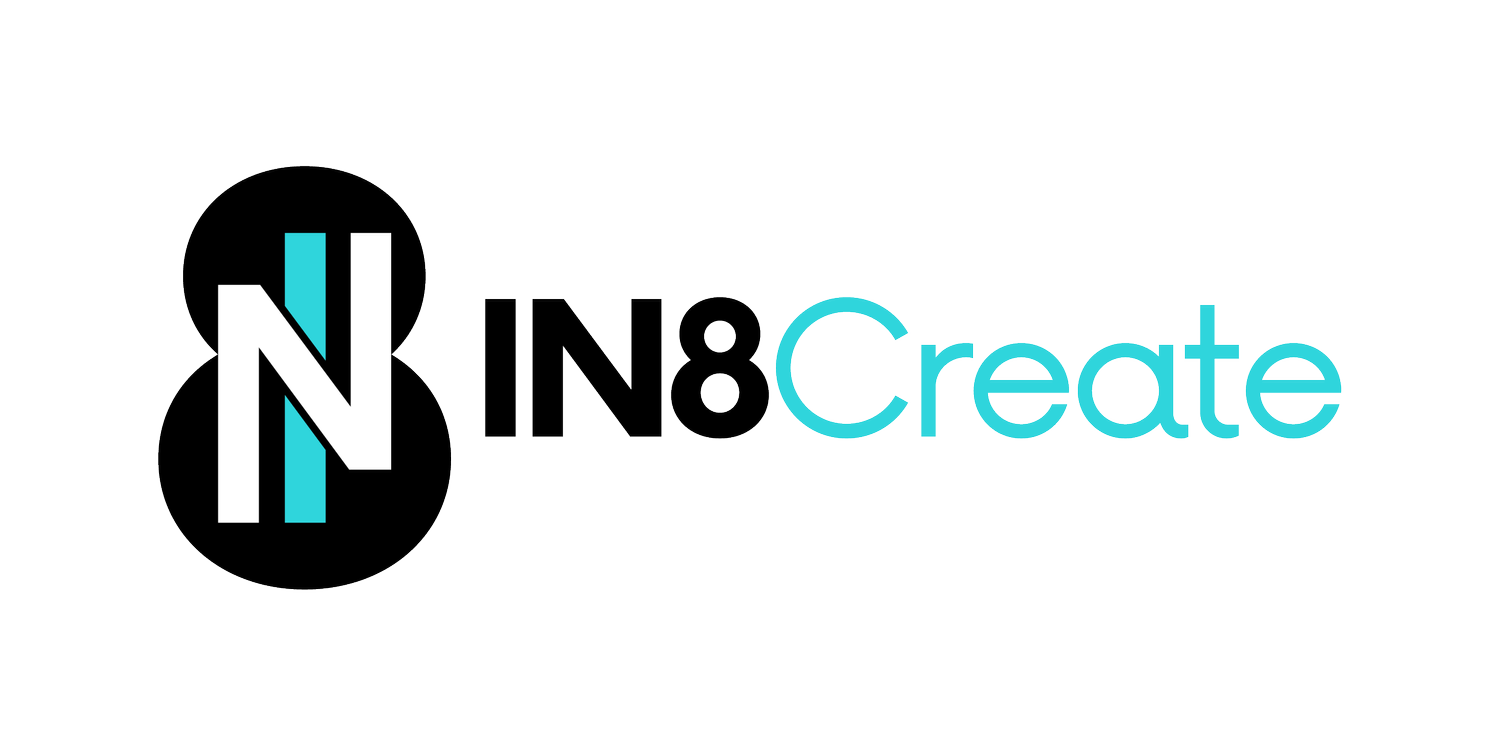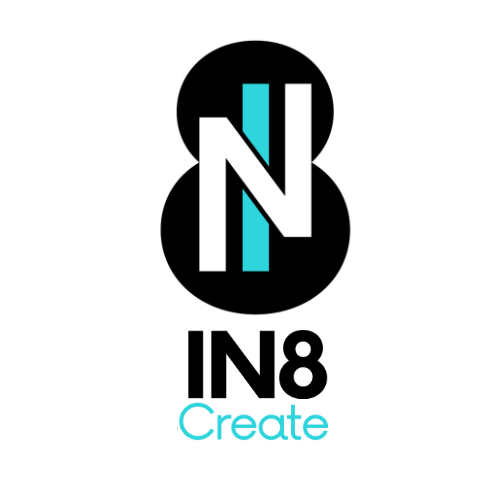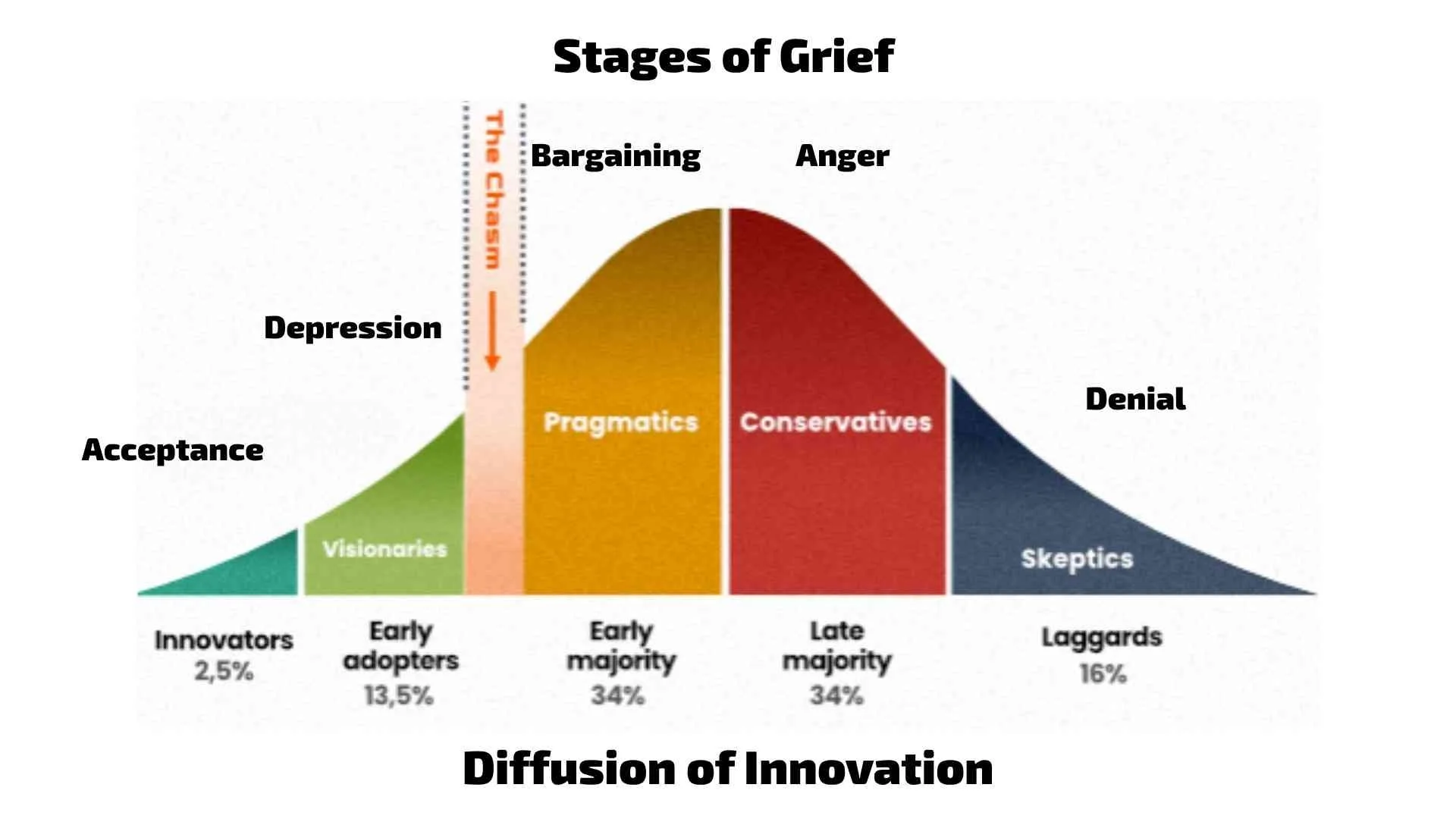Why Teams Respond to Change at Different Speeds
The Hidden Stages Everyone Goes Through During Change
You roll out a new initiative. You've done the research, built the business case, and created the perfect implementation plan. But six months later, you're looking at a team where some people are thriving with the change, others are actively resisting, and most are somewhere in the middle—confused, frustrated, or just going through the motions.
Sound familiar?
Here's what most leaders miss: Change isn't a light switch. It's a journey through distinct psychological stages, and everyone's traveling at their own pace.
The Stages Are Real (and Predictable)
When you introduce change—whether it's a new tool, process, reorganization, or way of working—you're asking people to move through a predictable sequence of psychological stages. These stages show up across three different frameworks that, remarkably, tell the same story:
Innovation Adoption → Change Transition → Grief Response
The pattern reveals itself clearly:
Innovators have already achieved Mastery and reached Acceptance
Early Adopters are in Integration mode, processing their Depression
Early Majority are experiencing New Beginnings and still Bargaining
Late Majority are stuck in the Neutral Zone, expressing Anger
Laggards are facing Endings while in complete Denial
Notice something? The people who seem most resistant to your change initiative aren't being difficult—they're grieving. And the people who've already embraced it? They've completed their grief work.
Your Team Will Land in Different Places
Here's the uncomfortable truth: You cannot expect everyone to respond to change at the same speed or in the same way.
When you announce a new direction, roughly:
2.5% will be excited and ready to go immediately (your Innovators)
13.5% will be cautiously optimistic and want to help lead (your Early Adopters)
34% will wait to see how it goes before committing (your Early Majority)
34% will be skeptical and need significant proof (your Late Majority)
16% will resist until they have absolutely no choice (your Laggards)
This isn't a personality flaw. It's human nature. Some people need more time and more support than others to process what's being asked of them. Pushing everyone to move at the same pace doesn't accelerate adoption—it creates resentment and burnout.
Change Means Losing an Imagined Future
Here's what makes change so painful: Every person on your team had an imagined future in their mind. That future is now gone.
Your engineer thought she'd spend the next year mastering the current tech stack. Your project manager imagined leading teams using the workflow he'd perfected. Your designer had plans for the creative direction she'd been building toward.
Then you announced the change. And all those imagined futures—the ones they'd been quietly working toward, planning around, building their identity on—disappeared.
You're not just asking people to learn something new. You're asking them to grieve what they thought was coming and accept the uncertainty of what actually is. That's hard work. That takes time. That requires emotional processing, not just logical understanding.
Change Requires Energy (and Your Team is Already Moving)
Think about physics for a moment. An object at rest stays at rest. An object in motion stays in motion. Your team isn't at rest—they're in motion. They have momentum in a specific direction.
When you introduce change, you're asking them to:
Slow down their current momentum
Stop completely
Redirect their energy toward something new
Build new momentum in a different direction
This takes enormous effort. It's not just learning a new tool or process—it's changing direction mid-sprint while carrying everything they're already responsible for.
And here's the thing about momentum: the faster someone was moving in the old direction, the harder it is to change course. Your best performers in the old system often struggle most with the new one, not because they're incapable, but because they have the most momentum to redirect.
People aren't just "figuring out" the new way—they're actively dismantling puzzle pieces they'd carefully assembled and trying to build something new while the picture on the box keeps changing. That cognitive and emotional work is exhausting.
What Leaders Can Actually Do
If you can't control the stages, and you can't make everyone move at the same pace, what can you do?
1. Listen More Than You Talk
Your job isn't to convince people faster. It's to understand where they are in their journey.
When someone says "This won't work here," they're in Denial. They need time to process the ending of the old way.
When someone says "Why are we doing this?" they're in Anger. They need space to express frustration.
When someone says "What if we just..." they're Bargaining. They're trying to negotiate how this change fits their world.
Don't rush past these stages. Ask questions. Get curious. "What concerns you most about this change?" "What would you need to feel more confident?" "What's working that you're worried we'll lose?"
2. Ask Questions That Reveal Stage, Not Just Resistance
Instead of "Are you on board with this?" try:
"What about the old way worked well for you?" (helps people process Endings)
"What's the hardest part of making this shift?" (validates the Neutral Zone)
"What would success look like for you with this new approach?" (invites New Beginnings)
"Who else on the team is figuring this out in a way that makes sense?" (builds toward Integration)
3. Lean on Your Champions
Your Innovators and Early Adopters are your secret weapon. They've already processed their grief. They've built momentum in the new direction. They're ready to help.
But here's the key: Don't ask them to convince skeptics. Ask them to support people one stage behind them.
Innovators can support Early Adopters (Depression → Acceptance)
Early Adopters can support Early Majority (Bargaining → Integration)
Early Majority can support Late Majority (Anger → New Beginnings)
Peer support works because it comes from someone who's been exactly where they are—recently enough to remember what it felt like.
4. Provide Structure for the Wilderness
The Neutral Zone—that messy middle where people are confused, uncertain, and neither here nor there—is where most change initiatives die.
People need structure during uncertainty:
Clear milestones: "By next month, you should be able to..."
Safe spaces to fail: "This is our practice period. Mistakes are expected."
Regular check-ins: "Let's talk about what's working and what's not every two weeks."
Visible progress markers: "Here's what we've learned so far as a team..."
Don't just communicate the destination. Illuminate the path through the wilderness.
A Real-World Example: AI Integration
Let's make this concrete. Your company decides to integrate AI tools into everyone's workflow. Here's how the stages play out:
Stage 1: The Innovators (2.5% - Mastery/Acceptance)
"I've already been using ChatGPT for months. This is great!"
What they need: Advanced training, opportunities to experiment with cutting-edge applications, permission to push boundaries.
What you do: Make them your lighthouse. Have them document what they're learning. Create a channel where they share experiments. Don't expect them to slow down.
Stage 2: Early Adopters (13.5% - Integration/Depression)
"I see the potential, but I'm processing what this means for my role."
What they need: Deep conversations about implications, time to process identity shifts, opportunities to shape implementation.
What you do: Hold space for their concerns. Ask them to document best practices. Give them a voice in how this rolls out. Their depression is them doing the deep work of integration.
Stage 3: Early Majority (34% - New Beginnings/Bargaining)
"Show me exactly how this fits into my current workflow."
What they need: Concrete use cases, step-by-step guides, examples from their peers, permission to start small.
What you do: Connect them with Early Adopters who can show them the path. Provide templates and starting points. Celebrate small wins. Let them negotiate their own entry point.
Stage 4: Late Majority (34% - Neutral Zone/Anger)
"This feels like more work, not less. Why are we doing this?"
What they need: Proof that others like them have succeeded, clear mandates (the decision is made), support through confusion, permission to be frustrated.
What you do: Stop selling benefits. Start providing structure. "Here's the minimum viable usage. Here's who can help you. Here's your deadline." Create peer support groups. Validate that this is hard.
Stage 5: Laggards (16% - Endings/Denial)
"I don't need AI. What I'm doing works fine."
What they need: Time to grieve their expertise, clear non-negotiables, witnessing others succeed, understanding that the old way is truly ending.
What you do: Be clear that change isn't optional. Provide the most structured path possible. Pair them with Late Majority members who just made it through. Acknowledge what's being lost. Set firm expectations.
The Bottom Line
Change isn't a problem to be solved—it's a human process to be supported. Your job as a leader isn't to make everyone move faster. It's to:
Recognize where people are in their grief/transition journey
Meet them there with appropriate support
Create structures that help them move through the stages
Leverage champions who've already made the journey
Accept that different speeds are normal, not a failure of your implementation
The teams that navigate change best aren't the ones that move fastest. They're the ones that move together—at different speeds, with different needs, but in the same direction.
Your quiet engineer isn't being stubborn. She's grieving the mastery she'd built and trying to puzzle together a new identity. Give her time. Give her structure. Give her someone who just figured it out to talk to.
That's how change actually happens. Not in an all-hands meeting announcing the new direction. But in a hundred small moments where people feel heard, supported, and guided through their own personal journey from what was to what will be.
Want to explore how your team is experiencing change? The conversations you're not having might be the ones that matter most.
Related Posts:
1. Creating A Resilient, Future-Ready Workforce



